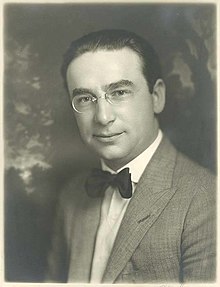B. Marcus Priteca
B. Marcus Priteca | |
|---|---|
 | |
| Born | Benjamin Marcus Priteca 23 December 1889 Glasgow, Scotland |
| Died | 1 October 1971 (aged 81) Seattle, Washington, U.S. |
Benjamin Marcus Priteca
Early life
Benjamin Marcus Priteca was born into a Jewish family in Glasgow on 23 December 1889.[1] His nickname was "Benny".[2] He served an apprenticeship in Edinburgh under architect Robert MacFarlane Cameron from 1904 to 1909, and earned degrees from the University of Edinburgh and the Royal College of Arts during this time.[3] In 1909, he emigrated to the U.S. and settled in Seattle.[3]
Career
Priteca met Seattle vaudeville theatre owner Alexander Pantages in 1910 and won a commission from him to design the San Francisco Pantages Theater (1911), the first of many so-named vaudeville and motion picture houses in what would become one of the largest theater chains in North America.
In all, Priteca designed 22 theaters for Pantages and another 128 for other theater owners. Notable theaters include the
Priteca also designed the 1934 Grandstand and Clubhouse of
Priteca's apprentices included
Death
Priteca died in Seattle on 1 October 1971, at the age of 81.[7] His first name was mistakenly recorded as "Bernard" on his death certificate.[8] He was posthumously awarded honorary membership of the Theatre Historical Society of America.[3]
Works
Theaters
- Pantages (1920) in Los Angeles, California (downtown)[2]
- Pantages in San Diego, California (1924)[2]
- Pantages (renamed The Orpheum) (1926) in
- Paramount (1929) in Seattle
- Hollywood, California(the last and largest of the Pantages theaters)
- Warner on Pacific Boulevard in Huntington Park, California (1930)
Other buildings
- Chevra Bikur Cholim synagogue (1912) in Seattle, now the Langston Hughes Performing Art Center
- Seattle's Crystal Pool natatorium (1916)
- Alhadeff Sanctuary of Seattle's Temple De Hirsch Sinai
- Civic Auditorium (now Keller Auditorium) in Portland
- Longacres racetrack clubhouse and grandstand in Renton, Washington[10]
Gallery
-
Priteca's Orpheum Theatre on Granville Street in Vancouver, c. 1946
-
Priteca's Pantages Theater inHollywood
-
Detail of Priteca's Chevra Bikur Cholim synagogue in Seattle, now the Langston Hughes Performing Art Center
-
Coliseum Theatre, Seattle under construction 1915
-
Terracotta Green Man, Coliseum Theatre, Seattle
-
TerracottaGriffins, Crystal Pool, Seattle
-
The Alhadeff Sanctuary of Seattle's Temple De Hirsch Sinai, a late Priteca project
-
Civic Auditorium (now Keller Auditorium) in Portland
-
Seattle's Crystal Pool natatorium, 1916
References
This article includes a list of general references, but it lacks sufficient corresponding inline citations. (May 2008) |
- ^ Normand, Eugene. "A Tale of Two Cities' Jewish Architects: Emile Weil of New Orleans and B. Marcus Priteca of Seattle". academia.edu. Retrieved 2015-09-09.
- ^ a b c d e f g h i j k l m Michelson, Alan (2015). "Benjamin Marcus Priteca". Pacific Coast Architecture Database. Retrieved 2018-02-11.
- ^ ISBN 9780295806891.
- ^ "B. Marcus Priteca - The Orpheum Theatre - History of Vancouver". www.vancouverhistory.ca. Archived from the original on 2016-08-29. Retrieved 2018-02-11.
- ISBN 978-0-8478-3062-6.
- ^ College of Fellows: History & Directory. The American Institute of Architects. 2000. p. 86.
- ^ "B. Marcus Priteca". The New York Times. 4 October 1971. p. 42. Retrieved 2018-02-11.
- ISBN 9780295806891.
- ^ "B. Marcus Priteca - The Orpheum Theatre - History of Vancouver". www.vancouverhistory.ca. Archived from the original on 2016-08-29. Retrieved 2018-02-11.
- ^ "Grandstand and clubhouse at Longacres racetrack, 1935".
- Biographical sketch of B. Marcus Priteca (with photographs) at Puget Sound Theatre Organ Society
- Statt, Daniel, Pantages, Alexander (1876-1936), HistoryLink.org Essay 2999, February 19, 2001, Corrected December 18, 2002. Accessed 10 March 2007.
External links
- "Movie Theaters Designed by Benjamin Marcus Priteca". Cinema Treasures.









